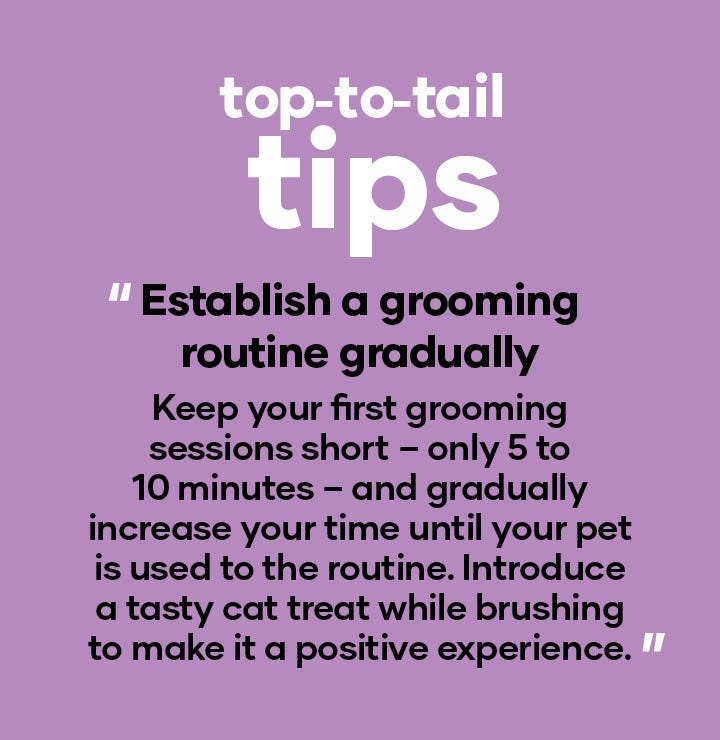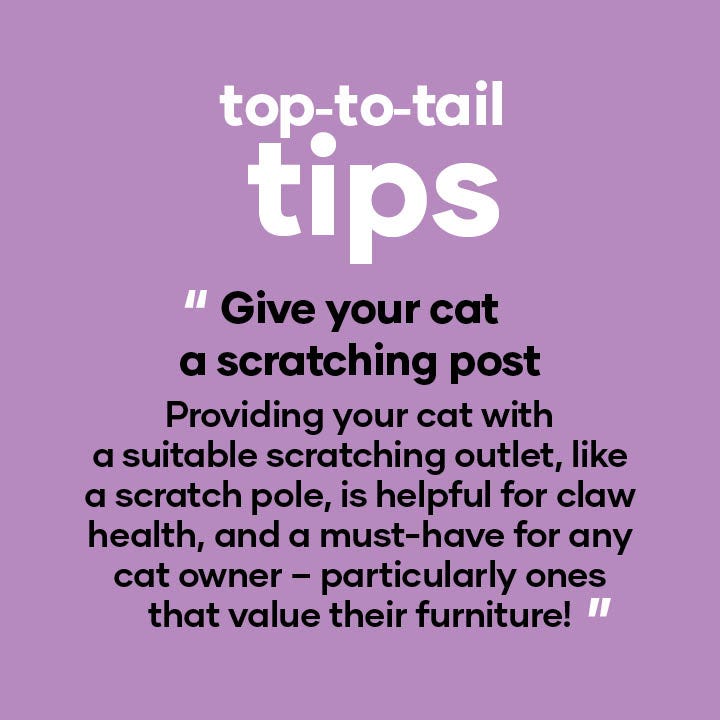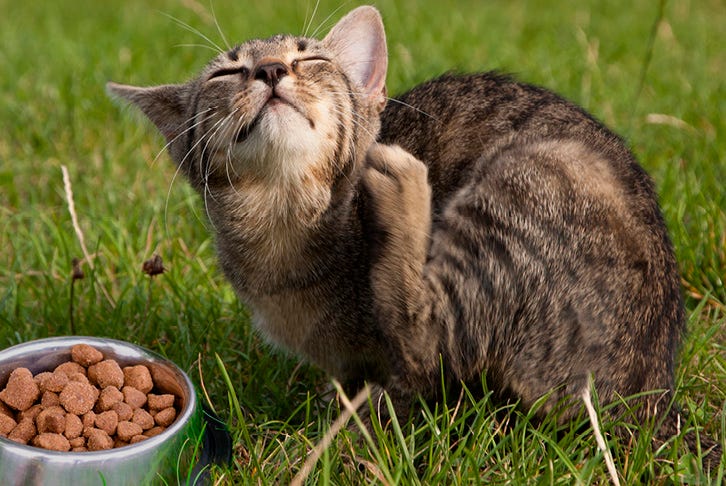How to groom your cat at home
Cats are keen self-groomers. In fact, they spend one third of their waking hours grooming themselves. However it’s important that you brush, comb and even bathe your cat to reduce matted hair, the risk of hairballs, and to promote a healthy coat.
Your cat’s self-grooming ritual
Each cat will have their own particular grooming ritual and this does more for them than simply keeping them clean. Self-grooming is a soothing ritual for cats that helps them relax. That barbed tongue of theirs is adept at removing loose hair. It may also help to spread their natural oils over their coat, which gives cats that natural lustre and healthy look. Cats’ tongues also help to remove fleas from their coat, but this alone is not enough to protect them from the parasites in your area. Speak to your local Animates team member to find the right products to protect your cat from fleas, ticks and worms.
Can I groom my cat at home?
Yes, bathing and grooming your cat at home can help reduce many problems, such as matted and redundant fur which can lead to hairballs. It is also a great way to manage the amount of cat hair that is shed in the house. The best time to introduce grooming is when they’re a kitten so they become familiar and comfortable with this process. Groom your cat at home when they are in a relaxed mood, for example after a nap.
Things to focus on when grooming your cat are:
- Brushing and combing your cat
- Bathing your cat if necessary
- Checking their teeth
- Checking their ears
- Trimming their nails if necessary
Of course, if bathing and grooming your cat seems like too much of a task for you, bring your pet into your local Animates Vetcare clinic where the professionals will be happy to do this for you.

Even though cats are skilled self-groomers, they still need your help to keep their coat in the best condition so it’s important that you devote some time each day to grooming them with dedicated cat brushes and combs. This is best done several times a week when they are kittens. Most adult cats will also enjoy this pampering experience.
Begin grooming your cat with long, gentle strokes down your cat’s back to get them comfortable, and then move onto their legs, head and tummy.
The benefits of brushing your cat include:
- Distributing their natural oils, helping them maintain their healthy skin and coat
- Addressing any tangled or knotted fur before becoming too matted
- Checking for parasites like fleas and ticks
- Checking for any skin abnormalities or ear problems
- Spending time deepening the bond with your cat
- Desensitising your cat to being handled
- Reducing the amount of hair your cat will swallow, and therefore the formation of hairballs
 For short-haired cats, a simple groom with a slicker brush or bristle brush to spread their coat’s natural oils and enhance the shine will be enough. Medium and long-haired breeds should receive a little more attention in the grooming department, so start with a moulting comb or pin brush to gently remove tangles before switching to a finishing brush. Gentle, slow and steady is the key.
For short-haired cats, a simple groom with a slicker brush or bristle brush to spread their coat’s natural oils and enhance the shine will be enough. Medium and long-haired breeds should receive a little more attention in the grooming department, so start with a moulting comb or pin brush to gently remove tangles before switching to a finishing brush. Gentle, slow and steady is the key.
The aim is to comb away any loose hair to avoid the likelihood of hairballs, and to prevent matting. Your daily grooming ritual is also a great opportunity for you to monitor your cat’s health by inspecting their skin for ticks, lumps, wounds or other skin concerns. If your cat’s fur is excessively mated, it’s best to take them into local Animates Vetcare clinic where professionals can remove the mats and help you clean delicate areas of your cat such as their eyes, ears and mouth.
It’s rare that your cat will need a full bath (and some cats may never need a bath), but their curious natures can get them into sticky situations every once in a while.
If it's necessary to bathe your cat, follow these steps:
- Add a small amount of warm water to a laundry sink or bathtub. A non-slip mat maybe be of benefit for your cat to stand on
- Slowly and calmly, use a sponge or similar item to wet your cat
- Use a cat shampoo to lather over their whole body. Avoid getting the shampoo in your cat’s eyes.
- Gently and thoroughly rinse your cat, without wetting your cat’s eyes and the inside of their ears
- Gently dry your cat with a towel
- Reassure your cat through each step of their bath and be sure to reward their good behaviour with healthy cat treats.
If your cat only has a small stain on their fur, you can do a spot clean with grooming wipes, which is less stressful on your cat than a full bath. A great option, especially for cats that are not a fan of being bathed, is waterless shampoo, which removes dirt and deodorises your pet. After brushing your cat, simply massage the dry shampoo into their fur, give the absorbent ingredients time to set, and then comb it out.
Believe it or not, taking care of your cat’s dental health is just as important as looking after your own! In addition to annual vet check-ups, brushing a cat’s teeth at home is an effective way to reduce dental plaque and maintain long-term oral health. Like humans, brushing will not only prevent plaque and tartar formation; it will also promote healthy gums and reduce halitosis (bad breath).
When planning to brush your cat’s teeth it is important to use the correct equipment. Ensure you use pet specific toothpaste, as human toothpaste is harmful for pets.
Follow these steps to establish your cat’s daily dental cleaning routine:
- For the first couple of days, build up your cat’s trust by placing a small amount of toothpaste onto your finger and offering it to him/her. Some cats will instantly love the taste while others may be a bit reluctant. If reluctant, try placing a tiny amount onto your cat’s nose. Your cat will hopefully lick it off and usually, once they have had a taste of it they will take it from your hand.
Note: there are several flavours of pet-specific toothpaste available, but if your cat is not a fan it's still worth brushing without toothpaste rather than giving up altogether. - The next step is to get your cat used to the sensation of touch on their lips, teeth and gums using your finger. Try putting a few drops of chicken/beef stock or tuna juice on your finger; they will begin to look forward to the ‘reward’ associated with this touch.

- Repeat this touch with a piece of flavoured (stock or tuna) cloth wrapped around your finger or a cotton wool bud. Start along their gum lines before lightly massaging their teeth and gums.
- Introduce the toothbrush and dip the toothbrush in the same flavour before holding it at a 45 degree angle to the tooth and gently brushing back and forth in a circular motion. Begin slowly with one or two strokes at the front of their mouth before continuing to their back teeth.
- Combine for the ultimate clean; it is now time to use both the toothbrush and paste together. Remember to start slowly and build up to at least 30 – 60 seconds on each side, sticking to a daily routine as much as possible. If your cat will not tolerate a toothbrush despite your best efforts, it is still worth ‘brushing’ their teeth regularly using a cloth or flannel wrapped around your finger.
Note: Kittens losing their baby teeth can be painful it is recommended that you stop teeth brushing until their permanent teeth come in. - After you have finished brushing their teeth create a positive association by giving your pet a small treat and of course a big cuddle!
Make sure to check their ears
You should regularly check your cat’s ears to look for signs of infection, bad odours, increased scratching of the ear, dark debris around the ear and excessive ear wax. If your cat displays any of these symptoms you should take them to your local Animates Vetcare clinic for a check-up. Home cleaning of cats’ ears can be fraught with complications and should only be done under the guidance and recommendation of your Animates Vetcare Vet.




















